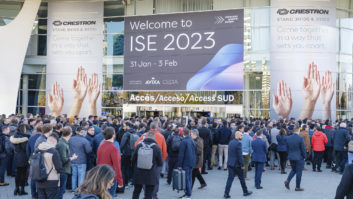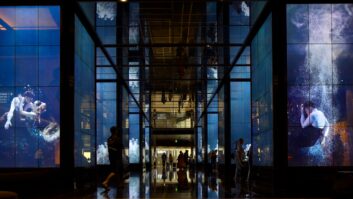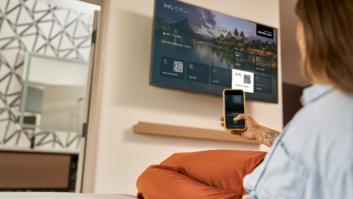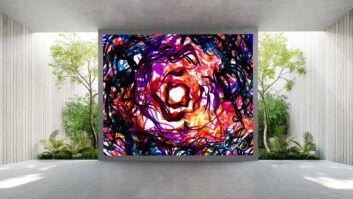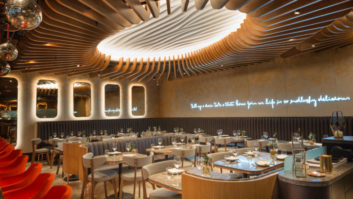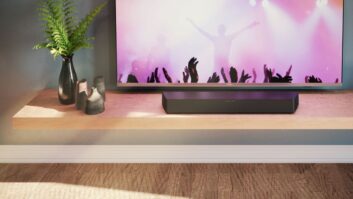With growing expectations from customers and opportunities in conference and leisure spaces, as well as in guest rooms, the potential for AV companies in the hotel sector is huge. Ian McMurray finds out more.
The fact that major AV manufacturers such as Crestron and LG have managers identified to take responsibility for the hotel market sector is indicative of the importance those companies attach to the opportunity. If anything, it’s perhaps surprising that more manufacturers haven’t done the same: with guest rooms, leisure facilities, public areas and conference suites, hotels are prospects for everything from flatscreen TVs and speakers, to digital signage, projectors and control systems.
There is also a unique conundrum for hotels: they are challenged not only by what their competitors are doing, but also by the technology that guests – whether for leisure or for business – take for granted.
“Consumers and business travellers expect to match what they have at home – they’re reluctant to trade down,” says Oliver East, business manager for LG’s hotel TV business in the UK and Ireland. “A hotel that hasn’t invested in room technology will find it hard
to compete.”
“The hospitality sector has fallen behind the residential sector in terms of technology,” explains Mark Coombes, hotel business development manager at Crestron. “Basically, hotel rooms have lost the wow factor. Once upon a time you’d stay in a five-star hotel and be blown away – but not any more. Your living room at home is likely to be more technologically advanced than a five-star guest room. To their credit, hotels are waking up to this and want to get back the wow factor.”
And while there is a good level of activity in public areas and conference facilities, it seems that it is indeed the in-room experience on which many hotels are focusing. As Pammi Mudhar, B2B sales and marketing director for Samsung Electronics Europe, points out: “Guest rooms is the larger market if only because a hotel will have many more guest rooms than conference facilities.”
On TV
Most visible in terms of guest rooms is, of course, the TV – and that’s an opportunity being actively pursued by Samsung and LG, both of which have products specifically designed for hotels. LG, for example, won an order for 215 of its LG 300c hotel TVs to equip the recently opened Radisson Blu Hotel in Cardiff. Samsung claims to have acquired 20% of the hotel TV market in the past couple of years.
East believes the switchover to digital broadcasting will have an important effect on the sector – but that is unlikely to be the last significant change to a hotel’s TV infrastructure. Like most other AV markets, it is headed in the direction of IP. “The challenge – especially in a retrofit – is to incorporate the legacy equipment where we can,” he says, “and then develop a future-proof system that can accommodate any changes in technology as they happen.”
A discernible trend is the expectation of guests to be able to bring their own technology with them, and to be able to use it in the room. “Many guests are coming into rooms with their own gadgets and their own content,” notes Mudhar.
“That’s something we’re definitely seeing,” agrees Tannoy’s Mark Flanagan. “Upmarket projects are demanding capabilities such as iPod docking stations. We recently supplied a substantial number of Tannoy i30 stations as part of a much wider Tannoy install at the Atlantis hotel resort on Palm Jumeirah, in Dubai, for example.”
It’s not just about TVs, though. Control4, which has traditionally been in the residential systems business, has developed a new set of products – the Control4 Suite Systems – aimed specifically at hotels. “The uptake has been fantastic,” says the company’s managing director Tony Leedham. “We see 2010 as being a good year.”
And in the same way that it’s not just about the TVs, it’s not just about the wow factor either. In common with many industries, hotels are looking to audiovisual systems to help them save money by saving energy. “It’s a huge issue for hotels,” says Coombes. “Right now, there are unoccupied hotel rooms all over the world with their lights blazing and air conditioning going flat out. Hotels know this situation is unsustainable and it needs addressing. It’s a major opportunity for integrators, and manufacturers.”
“Controlling the environment – not only in guest rooms, but throughout the facility – can have a real effect on a hotel’s bottom line,” adds Richard Newman, regional sales manager for AMX.
And, as Leedham points out, a project that can, in effect, pay for itself in the long term will always stand a good chance of being funded. “Accurate occupant monitoring is one way in which a hotel can save energy,” he says, “and our systems allow them to do that.”
He goes on to note that, in the same way as hotels worldwide now routinely offer their guests the opportunity to go green by deciding not to have their towels laundered, a number of hotels are now opting to give guests greater control over energy use in their rooms. Linking all the rooms on a network to provide centralised information on the status of all the equipment in a room is, he goes on to say, an opportunity for greater efficiency, greater guest satisfaction – and cost saving.
It’s possible to extend the scope of the system even further. “Integrating Crestron technology with customer relationship management systems is a really effective way to provide a high-quality product with good perceived value and to build a strong brand,” says Coombes.
“For example, Crestron systems allow you to monitor your guests’ in-room preferences; from what movies they watch and music they listen to, to the temperature and lighting preferences they have. This helps hotels build a sophisticated guest profile and provide a superior in-room experience and level of comfort with a view to more repeat business. This, in turn, contributes to a higher brand standard. This is the future.”
Sound investment
The other AV technology that can embrace all areas of a hotel is, of course, sound – and that’s the way Flanagan likes it. “We certainly see more business for Tannoy in projects where the requirement exists for all three areas – guest rooms, public spaces and conference facilities – particularly as it’s often more convenient for integrators to deal with just one loudspeaker supplier,” he says. “Tannoy can cater for all of them – and it helps our cause that the requirement is typically for high-quality sound reproduction.”
Coombes talks about ‘the brand’ – and for major hotel chains, that’s unquestionably important. Are there differences, then, between these chains and the smaller boutique hotels – or between hotels aimed at the business traveller as opposed to those targeting the leisure market?
“Major hotel chains are creating a brand, so that an AV solution will generally feel more ‘corporate’,” says AMX’s Newman. “Boutique hotels, on the other hand, will usually want a more unique, individual solution tailored to their needs.” Others point out that larger chains can be more difficult to deal with, more bureaucratic with a more convoluted procurement process. Decision cycles for boutique hotels are often shorter and based on personal relationships.
In terms of in-room and public facilities, there is little difference – in AV terms – between leisure hotels and business hotels. The main difference is, of course, in the provision of conference and meeting rooms.
“We’re seeing more activity there, and in public areas, than we are in guest rooms,” notes Newman. “It’s an incredibly competitive market, and hotels know they need to offer the latest AV technology if they’re to win the lucrative conferencing business.”
An example is the recently opened Sofitel at London’s Heathrow Terminal 5. Its 14 conference rooms are equipped with Christie projectors. “The hotel is now seeing a healthy influx of bookings at the expense of competitive hotels nearby,” notes Joe Graziano, UK sales channel manager for Christie, “and that’s unquestionably a function of the quality and range of AV services it provides.”
Like almost all markets, the hotel sector is far from recession-proof. That said, for the most part, the industry is positive about what’s going on, and about the prospects for the future. Samsung believes it will see its double-digit growth continue – and Flanagan at Tannoy is optimistic. “In terms of the coming year, we’re seeing definite signs that the market is picking up more momentum again, though slowly and surely,” he says. “A number of large hotel projects across Europe that had been held up in the past six to 12 months have started to come to fruition; hopefully, this is a good sign of things moving again.”
“The hotel industry can’t really afford any longer to offer substandard AV facilities in any part of its operation,” says Graziano. “Location, price, comfort, design – those are important. But how many guest rooms still have cathode ray tube TVs – and how many conference rooms still have inadequate projectors, screens, media players and connectivity?
“There can be little doubt: offering state-of-the-art audiovisual systems, whether in guest rooms, public areas, leisure facilities or conference suites, is becoming a key competitive differentiator and an opportunity to drive revenue and profit. Add to that the opportunity to save money, and it’s hard to know why any hotel isn’t looking hard at this aspect of its operations.”
